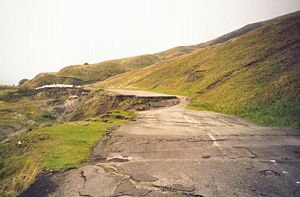Shear stress
A shear stress, denoted  (tau), is defined as a stress which is applied parallel or tangential to a face of a material, as opposed to a normal stress which is applied perpendicularly.
(tau), is defined as a stress which is applied parallel or tangential to a face of a material, as opposed to a normal stress which is applied perpendicularly.
Contents |
General shear stress
The formula to calculate a shear stress is:
where
 = the shear stress
= the shear stress- F = the force applied
- A = the cross sectional area
Other forms of shear stress
Beam shear
The formula for shear stress in a beam is:
where
- V = shear force at that location
- Q = statical moment of area
- t = thickness in the material perpendicular to the shear
- I = second moment of area of the cross section
This formula is also known as the Jourawski formula.[1]
Semi-monocoque shear

Shear stresses within a semi-monocoque structure may be calculated by idealizing the cross-section of the structure into a set of stringers (carrying only axial loads) and webs (carrying only shear flows). Dividing the shear flow by the thickness of a given portion of the semi-monocoque structure yields the shear stress. Thus, the maximum shear stress will occur either in the web of maximum shear flow or minimum thickness.
Also constructions in soil can fail due to shear; e.g., the weight of an earth-filled dam or dike may cause the subsoil to collapse, like a small landslide.
Impact shear
The maximum shear stress created in a solid round bar subject to impact is given.
The equation is
where
- U = Change in Kinetic Energy
- G = Shear Modulus
- V = Volume of Rod
and



 = Mass Moment of Inertia
= Mass Moment of Inertia = Angular Speed
= Angular Speed
Shear stress in fluids
A viscous, Newtonian fluid (including air and water) moving along a solid boundary will incur a shear stress on that boundary. The no-slip condition dictates that the speed of the fluid at the boundary (relative to the boundary) is 0, but at some height from the boundary the flow speed must equal that of the fluid. The region between these two points is aptly named the boundary layer. The shear stress is imparted onto the boundary as a result of this loss of velocity and can be expressed as
where
 is the dynamic viscosity of the fluid,
is the dynamic viscosity of the fluid, is the velocity of the fluid along the boundary, and
is the velocity of the fluid along the boundary, and is the height of the boundary.
is the height of the boundary.
Diverging fringe shear stress sensor
This relationship can be exploited to measure the wall shear stress. If a sensor could directly measure the gradient of the velocity profile at the wall, then multiplying by the dynamic viscosity would yield the shear stress. Such a sensor was demonstrated by A. A. Naqwi and W. C. Reynolds[2]. The interference pattern generated by sending a beam of light through two parallel slits forms a network of linearly diverging fringes that seem to originate from the plane of the two slits (see double-slit experiment). As a particle in a fluid passes through the fringes, a receiver detects the reflection of the fringe pattern. The signal can be processed, and knowing the fringe angle, the height and velocity of the particle can be extrapolated.
See also
- Shear modulus
- Shear rate
- Shear strain
- Shear strength
- Stress (physics)
- Tensile stress
References
- ↑ Timoshenko, Stephen P. (1983), History of Strength of Material, Courier Dover Publications, p. 141, ISBN 0486611876, http://books.google.com/books?id=tkScQmyhsb8C.
- ↑ Naqwi, A. A.; Reynolds, W. C. (jan 1987), "Dual cylindrical wave laser-Doppler method for measurement of skin friction in fluid flow", NASA STI/Recon Technical Report N 87
External links
- The second page of this brochure explains the concept of the diverging fringe shear stress sensor mentioned above.



